Accounting Principles Analysis and Homework Solution
VerifiedAdded on 2021/04/21
|7
|1552
|41
Homework Assignment
AI Summary
This document presents a comprehensive solution to an accounting principles homework assignment, analyzing key concepts through the lens of Apple Inc.'s financial statements. The assignment addresses the cost of assets, explaining how book value and accumulated depreciation are used to determine asset values. It details the concept of depreciation, contrasting the straight-line method with the diminishing value method and highlighting Apple's use of the straight-line approach. The solution explores depreciation and amortization expenses, showing how they are presented in the financial statements and how they have changed over time. It also examines the valuation of assets at cost, focusing on the increase in Apple's property, plant, and equipment. Finally, the assignment delves into intangible assets, such as goodwill and patents, discussing their treatment in the financial statements, including impairment testing and amortization policies. References from various academic journals are included to support the analysis.
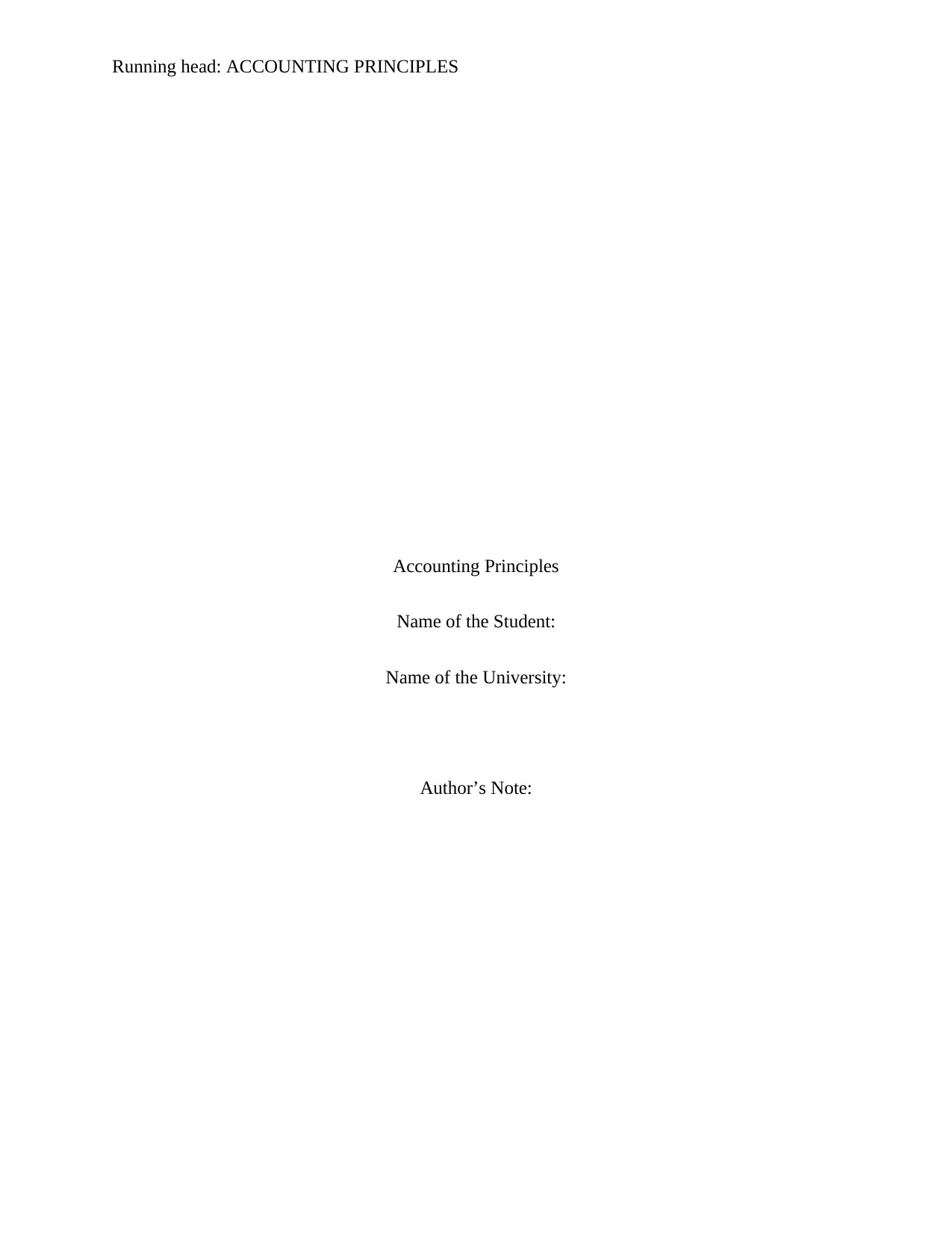
Running head: ACCOUNTING PRINCIPLES
Accounting Principles
Name of the Student:
Name of the University:
Author’s Note:
Accounting Principles
Name of the Student:
Name of the University:
Author’s Note:
Paraphrase This Document
Need a fresh take? Get an instant paraphrase of this document with our AI Paraphraser
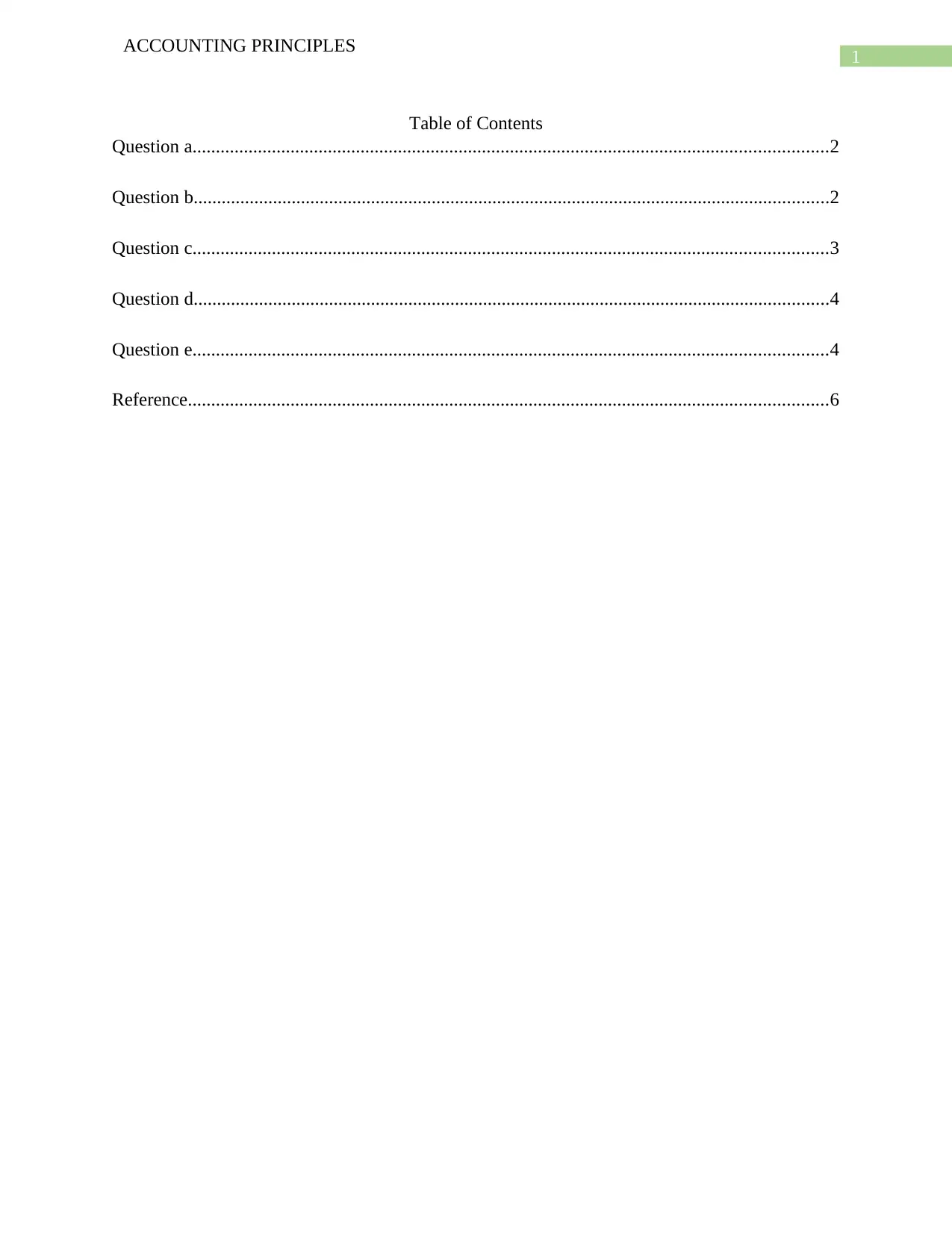
1
ACCOUNTING PRINCIPLES
Table of Contents
Question a........................................................................................................................................2
Question b........................................................................................................................................2
Question c........................................................................................................................................3
Question d........................................................................................................................................4
Question e........................................................................................................................................4
Reference.........................................................................................................................................6
ACCOUNTING PRINCIPLES
Table of Contents
Question a........................................................................................................................................2
Question b........................................................................................................................................2
Question c........................................................................................................................................3
Question d........................................................................................................................................4
Question e........................................................................................................................................4
Reference.........................................................................................................................................6
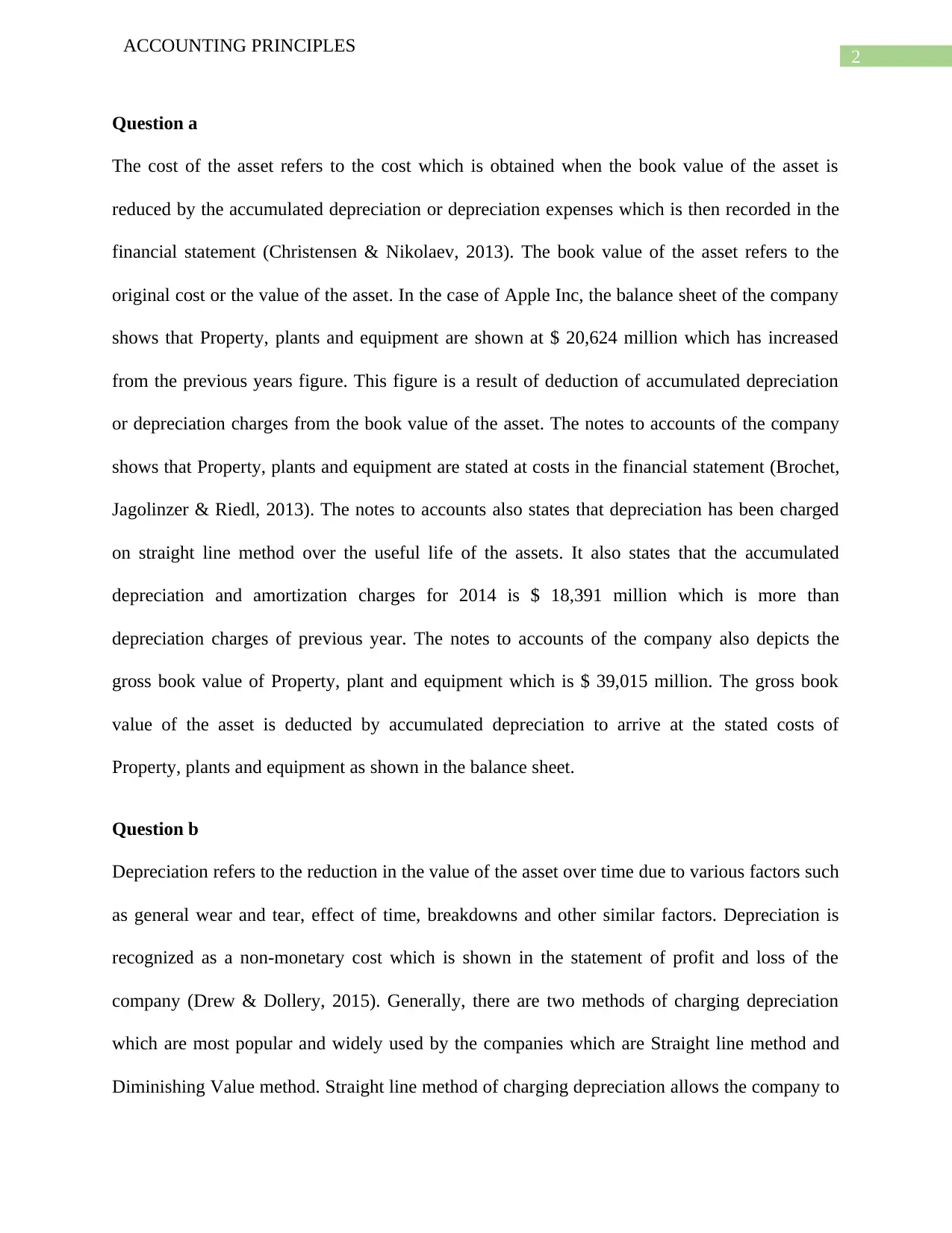
2
ACCOUNTING PRINCIPLES
Question a
The cost of the asset refers to the cost which is obtained when the book value of the asset is
reduced by the accumulated depreciation or depreciation expenses which is then recorded in the
financial statement (Christensen & Nikolaev, 2013). The book value of the asset refers to the
original cost or the value of the asset. In the case of Apple Inc, the balance sheet of the company
shows that Property, plants and equipment are shown at $ 20,624 million which has increased
from the previous years figure. This figure is a result of deduction of accumulated depreciation
or depreciation charges from the book value of the asset. The notes to accounts of the company
shows that Property, plants and equipment are stated at costs in the financial statement (Brochet,
Jagolinzer & Riedl, 2013). The notes to accounts also states that depreciation has been charged
on straight line method over the useful life of the assets. It also states that the accumulated
depreciation and amortization charges for 2014 is $ 18,391 million which is more than
depreciation charges of previous year. The notes to accounts of the company also depicts the
gross book value of Property, plant and equipment which is $ 39,015 million. The gross book
value of the asset is deducted by accumulated depreciation to arrive at the stated costs of
Property, plants and equipment as shown in the balance sheet.
Question b
Depreciation refers to the reduction in the value of the asset over time due to various factors such
as general wear and tear, effect of time, breakdowns and other similar factors. Depreciation is
recognized as a non-monetary cost which is shown in the statement of profit and loss of the
company (Drew & Dollery, 2015). Generally, there are two methods of charging depreciation
which are most popular and widely used by the companies which are Straight line method and
Diminishing Value method. Straight line method of charging depreciation allows the company to
ACCOUNTING PRINCIPLES
Question a
The cost of the asset refers to the cost which is obtained when the book value of the asset is
reduced by the accumulated depreciation or depreciation expenses which is then recorded in the
financial statement (Christensen & Nikolaev, 2013). The book value of the asset refers to the
original cost or the value of the asset. In the case of Apple Inc, the balance sheet of the company
shows that Property, plants and equipment are shown at $ 20,624 million which has increased
from the previous years figure. This figure is a result of deduction of accumulated depreciation
or depreciation charges from the book value of the asset. The notes to accounts of the company
shows that Property, plants and equipment are stated at costs in the financial statement (Brochet,
Jagolinzer & Riedl, 2013). The notes to accounts also states that depreciation has been charged
on straight line method over the useful life of the assets. It also states that the accumulated
depreciation and amortization charges for 2014 is $ 18,391 million which is more than
depreciation charges of previous year. The notes to accounts of the company also depicts the
gross book value of Property, plant and equipment which is $ 39,015 million. The gross book
value of the asset is deducted by accumulated depreciation to arrive at the stated costs of
Property, plants and equipment as shown in the balance sheet.
Question b
Depreciation refers to the reduction in the value of the asset over time due to various factors such
as general wear and tear, effect of time, breakdowns and other similar factors. Depreciation is
recognized as a non-monetary cost which is shown in the statement of profit and loss of the
company (Drew & Dollery, 2015). Generally, there are two methods of charging depreciation
which are most popular and widely used by the companies which are Straight line method and
Diminishing Value method. Straight line method of charging depreciation allows the company to
⊘ This is a preview!⊘
Do you want full access?
Subscribe today to unlock all pages.

Trusted by 1+ million students worldwide
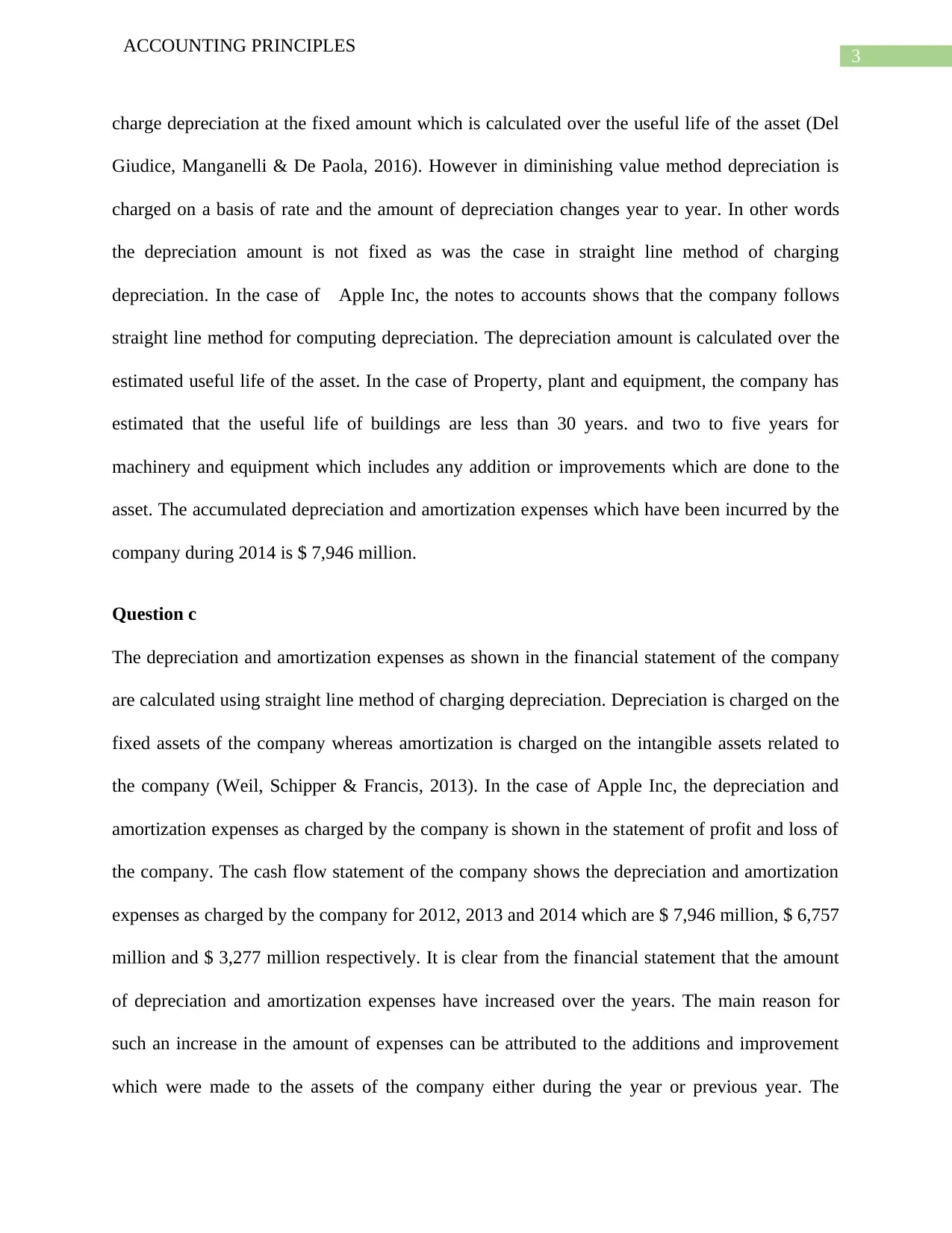
3
ACCOUNTING PRINCIPLES
charge depreciation at the fixed amount which is calculated over the useful life of the asset (Del
Giudice, Manganelli & De Paola, 2016). However in diminishing value method depreciation is
charged on a basis of rate and the amount of depreciation changes year to year. In other words
the depreciation amount is not fixed as was the case in straight line method of charging
depreciation. In the case of Apple Inc, the notes to accounts shows that the company follows
straight line method for computing depreciation. The depreciation amount is calculated over the
estimated useful life of the asset. In the case of Property, plant and equipment, the company has
estimated that the useful life of buildings are less than 30 years. and two to five years for
machinery and equipment which includes any addition or improvements which are done to the
asset. The accumulated depreciation and amortization expenses which have been incurred by the
company during 2014 is $ 7,946 million.
Question c
The depreciation and amortization expenses as shown in the financial statement of the company
are calculated using straight line method of charging depreciation. Depreciation is charged on the
fixed assets of the company whereas amortization is charged on the intangible assets related to
the company (Weil, Schipper & Francis, 2013). In the case of Apple Inc, the depreciation and
amortization expenses as charged by the company is shown in the statement of profit and loss of
the company. The cash flow statement of the company shows the depreciation and amortization
expenses as charged by the company for 2012, 2013 and 2014 which are $ 7,946 million, $ 6,757
million and $ 3,277 million respectively. It is clear from the financial statement that the amount
of depreciation and amortization expenses have increased over the years. The main reason for
such an increase in the amount of expenses can be attributed to the additions and improvement
which were made to the assets of the company either during the year or previous year. The
ACCOUNTING PRINCIPLES
charge depreciation at the fixed amount which is calculated over the useful life of the asset (Del
Giudice, Manganelli & De Paola, 2016). However in diminishing value method depreciation is
charged on a basis of rate and the amount of depreciation changes year to year. In other words
the depreciation amount is not fixed as was the case in straight line method of charging
depreciation. In the case of Apple Inc, the notes to accounts shows that the company follows
straight line method for computing depreciation. The depreciation amount is calculated over the
estimated useful life of the asset. In the case of Property, plant and equipment, the company has
estimated that the useful life of buildings are less than 30 years. and two to five years for
machinery and equipment which includes any addition or improvements which are done to the
asset. The accumulated depreciation and amortization expenses which have been incurred by the
company during 2014 is $ 7,946 million.
Question c
The depreciation and amortization expenses as shown in the financial statement of the company
are calculated using straight line method of charging depreciation. Depreciation is charged on the
fixed assets of the company whereas amortization is charged on the intangible assets related to
the company (Weil, Schipper & Francis, 2013). In the case of Apple Inc, the depreciation and
amortization expenses as charged by the company is shown in the statement of profit and loss of
the company. The cash flow statement of the company shows the depreciation and amortization
expenses as charged by the company for 2012, 2013 and 2014 which are $ 7,946 million, $ 6,757
million and $ 3,277 million respectively. It is clear from the financial statement that the amount
of depreciation and amortization expenses have increased over the years. The main reason for
such an increase in the amount of expenses can be attributed to the additions and improvement
which were made to the assets of the company either during the year or previous year. The
Paraphrase This Document
Need a fresh take? Get an instant paraphrase of this document with our AI Paraphraser
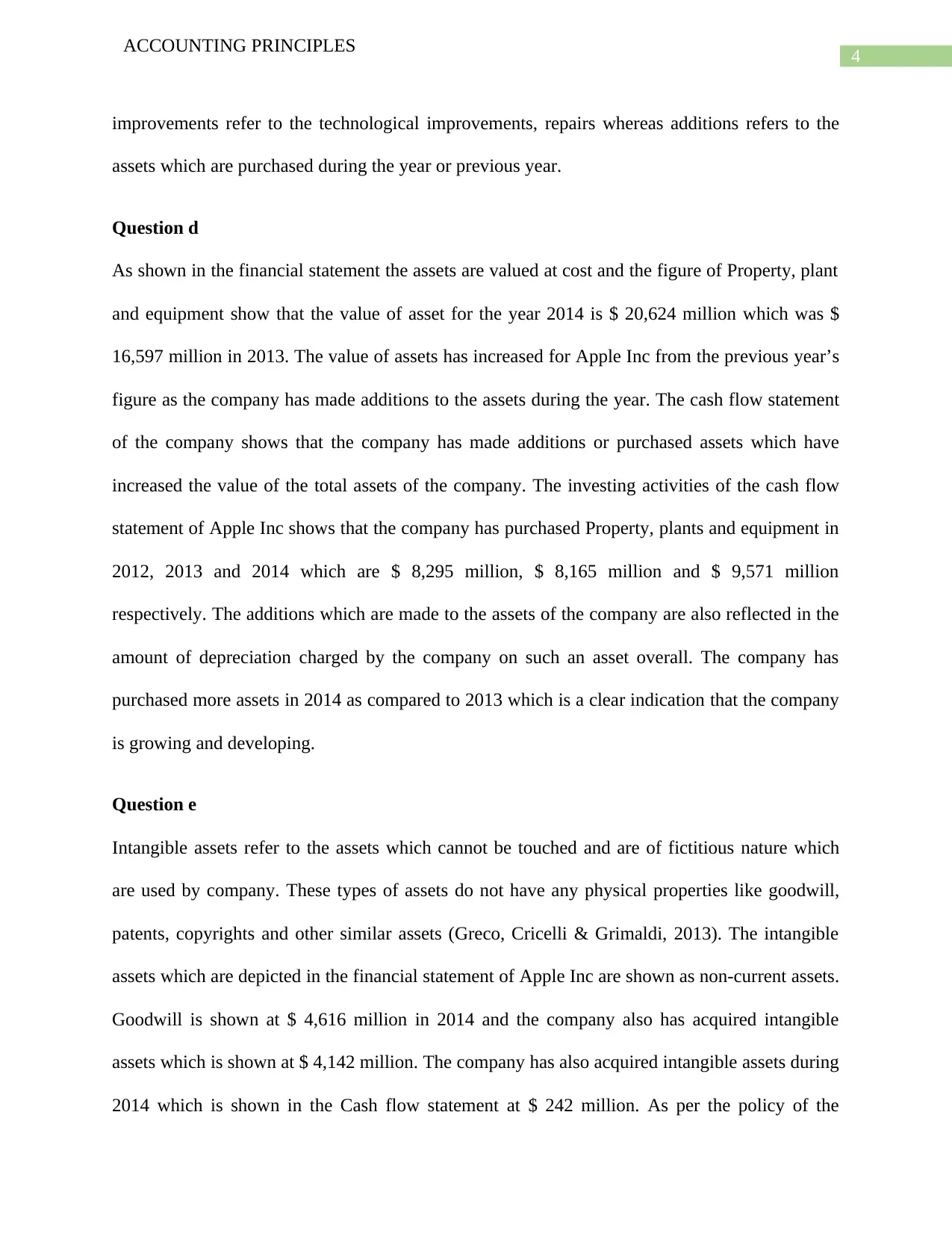
4
ACCOUNTING PRINCIPLES
improvements refer to the technological improvements, repairs whereas additions refers to the
assets which are purchased during the year or previous year.
Question d
As shown in the financial statement the assets are valued at cost and the figure of Property, plant
and equipment show that the value of asset for the year 2014 is $ 20,624 million which was $
16,597 million in 2013. The value of assets has increased for Apple Inc from the previous year’s
figure as the company has made additions to the assets during the year. The cash flow statement
of the company shows that the company has made additions or purchased assets which have
increased the value of the total assets of the company. The investing activities of the cash flow
statement of Apple Inc shows that the company has purchased Property, plants and equipment in
2012, 2013 and 2014 which are $ 8,295 million, $ 8,165 million and $ 9,571 million
respectively. The additions which are made to the assets of the company are also reflected in the
amount of depreciation charged by the company on such an asset overall. The company has
purchased more assets in 2014 as compared to 2013 which is a clear indication that the company
is growing and developing.
Question e
Intangible assets refer to the assets which cannot be touched and are of fictitious nature which
are used by company. These types of assets do not have any physical properties like goodwill,
patents, copyrights and other similar assets (Greco, Cricelli & Grimaldi, 2013). The intangible
assets which are depicted in the financial statement of Apple Inc are shown as non-current assets.
Goodwill is shown at $ 4,616 million in 2014 and the company also has acquired intangible
assets which is shown at $ 4,142 million. The company has also acquired intangible assets during
2014 which is shown in the Cash flow statement at $ 242 million. As per the policy of the
ACCOUNTING PRINCIPLES
improvements refer to the technological improvements, repairs whereas additions refers to the
assets which are purchased during the year or previous year.
Question d
As shown in the financial statement the assets are valued at cost and the figure of Property, plant
and equipment show that the value of asset for the year 2014 is $ 20,624 million which was $
16,597 million in 2013. The value of assets has increased for Apple Inc from the previous year’s
figure as the company has made additions to the assets during the year. The cash flow statement
of the company shows that the company has made additions or purchased assets which have
increased the value of the total assets of the company. The investing activities of the cash flow
statement of Apple Inc shows that the company has purchased Property, plants and equipment in
2012, 2013 and 2014 which are $ 8,295 million, $ 8,165 million and $ 9,571 million
respectively. The additions which are made to the assets of the company are also reflected in the
amount of depreciation charged by the company on such an asset overall. The company has
purchased more assets in 2014 as compared to 2013 which is a clear indication that the company
is growing and developing.
Question e
Intangible assets refer to the assets which cannot be touched and are of fictitious nature which
are used by company. These types of assets do not have any physical properties like goodwill,
patents, copyrights and other similar assets (Greco, Cricelli & Grimaldi, 2013). The intangible
assets which are depicted in the financial statement of Apple Inc are shown as non-current assets.
Goodwill is shown at $ 4,616 million in 2014 and the company also has acquired intangible
assets which is shown at $ 4,142 million. The company has also acquired intangible assets during
2014 which is shown in the Cash flow statement at $ 242 million. As per the policy of the
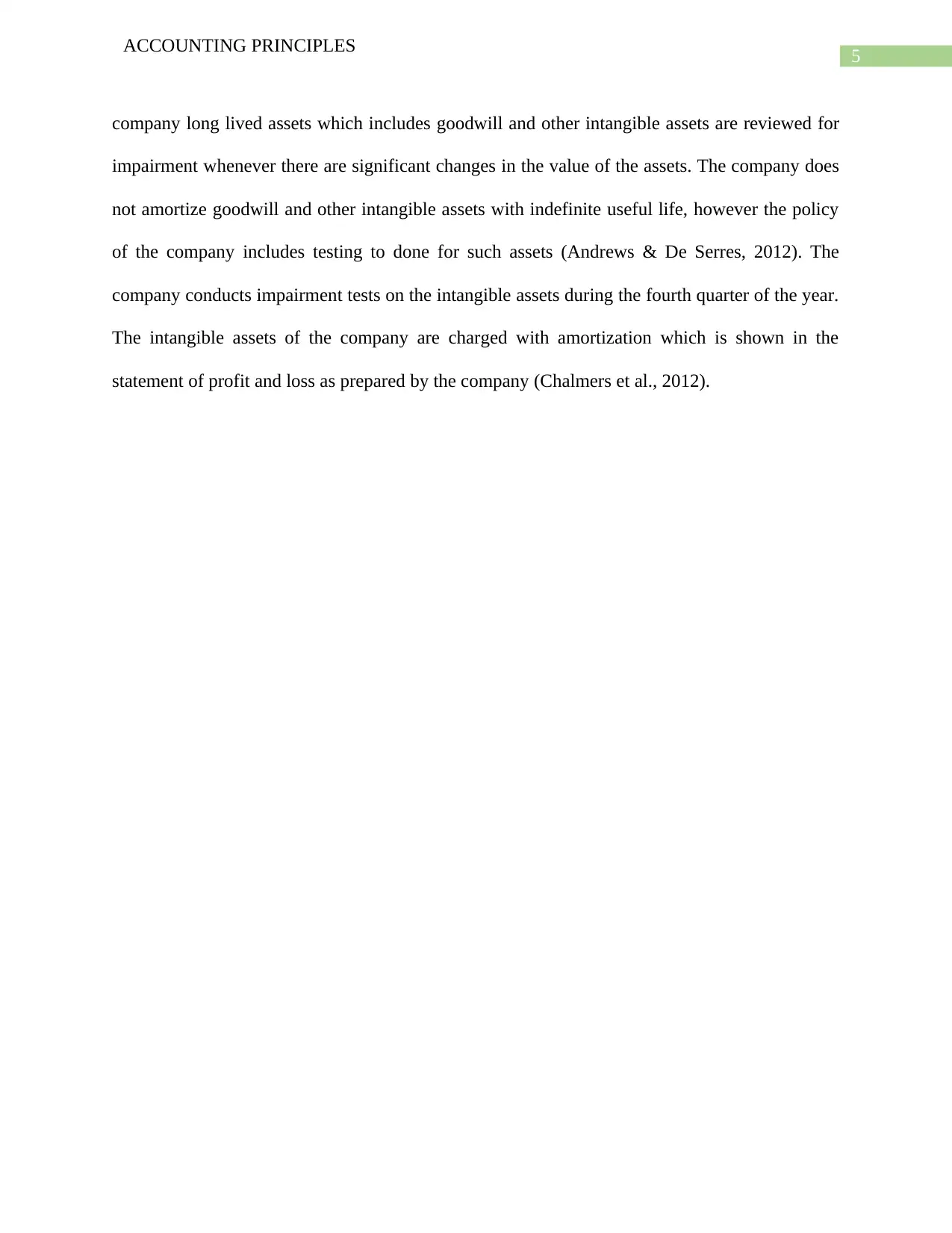
5
ACCOUNTING PRINCIPLES
company long lived assets which includes goodwill and other intangible assets are reviewed for
impairment whenever there are significant changes in the value of the assets. The company does
not amortize goodwill and other intangible assets with indefinite useful life, however the policy
of the company includes testing to done for such assets (Andrews & De Serres, 2012). The
company conducts impairment tests on the intangible assets during the fourth quarter of the year.
The intangible assets of the company are charged with amortization which is shown in the
statement of profit and loss as prepared by the company (Chalmers et al., 2012).
ACCOUNTING PRINCIPLES
company long lived assets which includes goodwill and other intangible assets are reviewed for
impairment whenever there are significant changes in the value of the assets. The company does
not amortize goodwill and other intangible assets with indefinite useful life, however the policy
of the company includes testing to done for such assets (Andrews & De Serres, 2012). The
company conducts impairment tests on the intangible assets during the fourth quarter of the year.
The intangible assets of the company are charged with amortization which is shown in the
statement of profit and loss as prepared by the company (Chalmers et al., 2012).
⊘ This is a preview!⊘
Do you want full access?
Subscribe today to unlock all pages.

Trusted by 1+ million students worldwide

6
ACCOUNTING PRINCIPLES
Reference
Andrews, D., & De Serres, A. (2012). Intangible assets, resource allocation and growth: A
framework for analysis. OECD Economic Department Working Papers, (989), 0_1.
Brochet, F., Jagolinzer, A. D., & Riedl, E. J. (2013). Mandatory IFRS adoption and financial
statement comparability. Contemporary Accounting Research, 30(4), 1373-1400.
Chalmers, K., Clinch, G., Godfrey, J. M., & Wei, Z. (2012). Intangible assets, IFRS and
analysts’ earnings forecasts. Accounting & Finance, 52(3), 691-721.
Christensen, H. B., & Nikolaev, V. V. (2013). Does fair value accounting for non-financial assets
pass the market test?. Review of Accounting Studies, 18(3), 734-775.
Del Giudice, V., Manganelli, B., & De Paola, P. (2016, July). Depreciation methods for firm’s
assets. In International Conference on Computational Science and Its Applications(pp. 214-
227). Springer, Cham.
Drew, J., & Dollery, B. (2015). Inconsistent depreciation practice and public policymaking:
Local government reform in New South Wales. Australian Accounting Review, 25(1), 28-37.
Greco, M., Cricelli, L., & Grimaldi, M. (2013). A strategic management framework of tangible
and intangible assets. European Management Journal, 31(1), 55-66.
Weil, R. L., Schipper, K., & Francis, J. (2013). Financial accounting: an introduction to
concepts, methods and uses. Cengage Learning.
ACCOUNTING PRINCIPLES
Reference
Andrews, D., & De Serres, A. (2012). Intangible assets, resource allocation and growth: A
framework for analysis. OECD Economic Department Working Papers, (989), 0_1.
Brochet, F., Jagolinzer, A. D., & Riedl, E. J. (2013). Mandatory IFRS adoption and financial
statement comparability. Contemporary Accounting Research, 30(4), 1373-1400.
Chalmers, K., Clinch, G., Godfrey, J. M., & Wei, Z. (2012). Intangible assets, IFRS and
analysts’ earnings forecasts. Accounting & Finance, 52(3), 691-721.
Christensen, H. B., & Nikolaev, V. V. (2013). Does fair value accounting for non-financial assets
pass the market test?. Review of Accounting Studies, 18(3), 734-775.
Del Giudice, V., Manganelli, B., & De Paola, P. (2016, July). Depreciation methods for firm’s
assets. In International Conference on Computational Science and Its Applications(pp. 214-
227). Springer, Cham.
Drew, J., & Dollery, B. (2015). Inconsistent depreciation practice and public policymaking:
Local government reform in New South Wales. Australian Accounting Review, 25(1), 28-37.
Greco, M., Cricelli, L., & Grimaldi, M. (2013). A strategic management framework of tangible
and intangible assets. European Management Journal, 31(1), 55-66.
Weil, R. L., Schipper, K., & Francis, J. (2013). Financial accounting: an introduction to
concepts, methods and uses. Cengage Learning.
1 out of 7
Related Documents
Your All-in-One AI-Powered Toolkit for Academic Success.
+13062052269
info@desklib.com
Available 24*7 on WhatsApp / Email
![[object Object]](/_next/static/media/star-bottom.7253800d.svg)
Unlock your academic potential
Copyright © 2020–2025 A2Z Services. All Rights Reserved. Developed and managed by ZUCOL.





